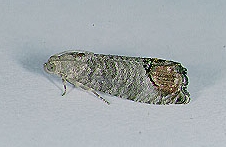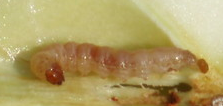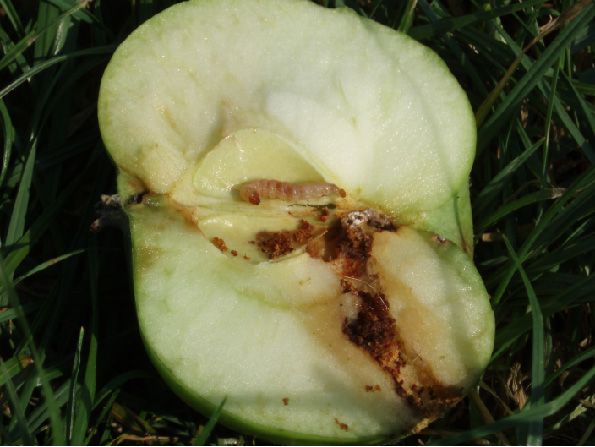Codling moth
Cydia pomonella
Aktuelle Warnungen
Current warning: Apfelwickler Beginn Falterflug 2. Generation in WienRegions: Wien
Time period: 02.07.2025 - 19.07.2025
Mit Hilfe der Käfigmethode wurde der Beginn des Apfelwickler-Fluges der Zweiten Generation am 02.07.2025 in Wien festgestellt. Die einsetzende Eiablage wird mit einer weiteren Warndienst-Meldung bekannt gegeben.
Show warning details Aktuelle Warnungen abonnierenAppearance


The codling moth belongs to the moth family (Tortricidae) among small butterflies. It has gray-brown forewings with irregular whitish stripes and a dark, golden shiny spot (eyespot) near the wing tip. The hind wings are uniformly light brown, the wingspan is about 20 mm.
The caterpillar (fruit maggot) has a brown head and is initially yellowish white, later pinkish yellow in color. It has a total of eight pairs of legs, including three jointed pairs on the thorax and five unjointed pairs on the abdomen, and grows up to 20 mm long.
Biology
The flight activity of the first generation begins in May during the apple blossom and lasts until the beginning of August. The flight mainly takes place in dry, warm and windless weather. The females lay their shiny silvery eggs on fruit and leaves. After a few days, the caterpillars hatch and bore their way into the still small fruit through the indentation at the base of the flower or the stem, initially under the skin of the fruit, until they later penetrate into the centre and destroy it with their feeding activity. In doing so, they leave behind faecal crumbs in the feeding tunnels, some of which also ooze out through the borehole. Three to four weeks later they leave the fruit and spin themselves into a white cocoon under bark scales and other tree hiding places. Some of the caterpillars pupate and develop into the moths of the second generation (from around the end of July), while the others go into a dormant phase (diapause) and overwinter. The first generation overlaps with the second generation, which lasts from the end of July to the beginning of September. The eggs of the second generation are laid on fruit, the caterpillars are found in the ripe fruit. The older caterpillars leave the fruit via spinning threads and overwinter in a cocoon in bark cracks on the trunk or in the ground. They do not pupate until the following spring.
There are two generations per year, in warm and dry regions up to three generations are possible. At higher altitudes and where the necessary temperatures for pupal development are not reached, there is only one generation.
Damage symptoms
A borehole filled with fecal crumbs is visible in one part of the fruit. Inside the fruit there is a feeding tunnel that leads to the destroyed core, which usually still contains the caterpillar. Infested fruits become not ripe and fall off prematurely.

Prevention and control
- Encourage natural enemies (e.g. birds)
- Regularly collect and destroy fallen fruit
- Attach corrugated cardboard rings to tree trunks from July onwards to intercept caterpillars that hide there over winter and then remove and destroy them with the corrugated cardboard.
- Use of pheromone traps to detect the start and progress of the flight of the moths
- In larger, uniform plants, pheromones (sexual attractants) can be applied before the moths start to fly to prevent the moths from finding their sex (confusion method). As a result, there are no fertilised eggs and no infestation occurs.
- Targeted treatment of pome fruit trees with plant protection products authorised for codling moth control (see list of plant protection products authorised in Austria). It is essential to ensure the correct treatment time and waiting period! The exact treatment dates are announced by means of warning service messages.
Specialist information
Publications
Lethmayer C., Hausdorf H., Altenburger J., Blümel, S., 2009. Trials of alternative codling moth (Cydia pomonella) control strategies in Austria. International Journal of Fruit Science, 9, 1-9.
Last updated: 21.10.2024
automatically translated
